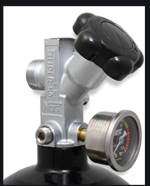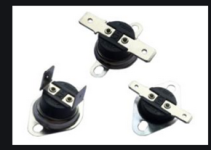Fullthrottleguy
Site Sponsor
- May 5, 2021
- 1,104
- 1,487
Sorry if this is way long - but I think its important ....
Those who have duned with me know I am a freak for fire safety. If you go fast in uncontrolled conditions stuff happens. I have seen first hand what fire can do, and some GD members (LRS comes to mind) have been in off road fires and its not fun.
Most Sand cars don't have fuel cells and firewalls, many have windshields, padded interiors and lots of Horsepower. The same is true for a lot of SxS with big power hungry lights and stereos and way more plastic than a sand car.
I started over 10 years ago putting fire systems on all my cars and many of my Buddies cars, not because I think a systems can put out a big fire, but because statistically you have a way better chance of making it out if you can slow down the fire, and you might just save the car if you are lucky.
If you have a little 2 or 5LB fire extinguisher in your car you basically are nit putting much out and likely not buying yourself anytime to "escape" and if you use it you will create a huge mess and ruin a lot of the car in the process (Paint, wiring, polished aluminum)
I am not a fire expert but I have learned a little and can say that the cost of a fire system is not even what I spend on fuel and food for weekend and a reasonable install can be done a couple hours by anyone .
So here is my take ....Essentially there are two types (yes there are more and combos of each) there is AFFF which is a foam fire retardant that smothers the flames and prevents re-ignition - its basically soap ... It's made of animal fat. Its great stuff, it hangs on to surfaces and if it wets you it stops the fire from burning you. it also goes by the other name cold Fire. There are a few brands of it - mainly from Europe and everyone but ESS IMO is inferior. ESS is the only one that creates the Foam in the container was the C02 cartridge that pressurizes it fires - that is a key to using it in Cars. they don't rely on the nozzle to make the foam (if sand gets in the nozzle of others - it comes out like soapy water - not effective.
Basically you fill a tank with water and a soap mix and when you pull a Handle - it shoots C02 from a cartridge into the tank and foams it, the solution travels through a tube and puts out the fire (more on that later). The downside of AFFF is that it freezes - well the water freezes or gets slushy and it does not work at all. people who run it in cold weather - like when Glamis gets cold at night - either keep the car in the trailer or use a heater blanket over the tank - neither is sure practical. a 2.5L Bottle is usually OK for 2 seat car and 5L is good for 4 seat car - it comes down to the number of Nozzles. I used these systems on mostly all cars. they are great for open cars "mostly" because foam lays down. Clean it is not as easy as regular soap and water due to the PH but it cleans up WAY better than an ABC fire extinguisher.
The second type is a Halon derivative - since Halon was outlawed due to environmental concerns, there are two new types 3M Novec 1230 and Dupont FE36 Both work by starving the fire of oxygen, but unlike Halon these are heavier than Air and Blanket and area faster than AFFF and they work good in mostly open cars and they leave No residue - so no clean up and they don't freeze.
I have used all three of these types - Firebottle brand uses FE36 and Safecraft uses Novec 1230. Firebottle was my goto early on because all the drag racers used it. I went to ESS for a long time because thinking like a racer again - it has the advantage of being able to refill at home cheaply where the others need to be sent back to refill and cost lots of $$
As a racer you can discharge a bottle by mistake and if you don't have a spare ir can't refill you cannot race. As a Duner if I ever have to use the Bottle I and likely not going duning the same weekend ..
Mu latest car I moved to safecraft because I wanted a mess free solution and they are supporting the sport a lot. They also have SxS specific kits that automatically put out "belt" fires and engine related fires with those (hot turbo oil on the exhaust type stuff)
All three of those systems come with Aluminum tubing and aluminum nozzles - thats important - the cheap systems that have plastic tubing usually fail because by the time you pull the handle to extinguish the fire, the tubing already melted and no material makes it out ...
====
The key to either is buy the right kit (number of nozzles and bottle size) and place the bottle and nozzles in the right spot
Ideally 3 rules:
1. Always cover the areas of ignition - on a sand car that means face the nozzles at the headers and Fuel injectors. If I have extra nozzles I will also target the fell pump, but I have never seen one short and cause a fire. I have been told so many times not to bother pointing nozzle at the gas tank because there is no way you are going stop gallons of fuel from coming out, so theta just a complete waste
2. save the occupants - face a nozzle at the feet of the occupants since fuel fires usually travel along the floor. If you have extra nozzles face then the back of the heads of the occupants this way you are covered no matter where you are even upside down
3. Place the pull handle where both front seat occupants can get to it and / or someone outside can pull it
You also need to know the system and how the nozzles spray. For instance the ESS has small nozzles and you can place they straight up and down (just use common sense on direction of the spray) No sand is "likely "getting in the nozzle and down the tube. The Firebottle and Safecraft use Big Nozzles and you should mount them upside down so no sand gets in the tune and clogs it up.
Also pay attention to how you place the bottle even though you might be on your side, I always place it assuming I am gonna be right side up or upside down. It makea difference in efficiency. while there is way more to cover. these are basics - here are a couple pics of the stystm I did in my car recently
While the kit comes with aluminum line and you have to 37 degree flare the ends (like AN) to install you can use a 45 degree stand flare tool and aluminum "gives" enough to seal, I like using stainless tubing, its harder to work with but it allows me to mount nozzles cleaner with less support. Bottle is horzontal with gauge up and mounted through the floor securely - it only weighs 5 lbs But I don't want it dislodging in crash
Here are some pics of this and previous Install ...
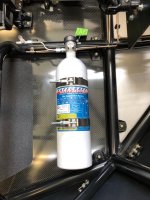
I T'd the line so I could get a nozzle for Driver and Passenger. I tapped and plugged the center hole on the nozzle to give side squirter more force. I made a bracket to hold the Bulkhead T more securely.
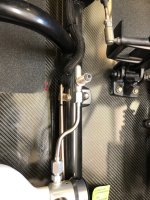
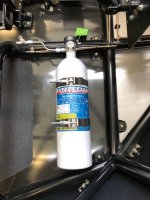
I bent the stainless line do the nozzle points down to keep sand and crap out of the lines - I did the same in the back of the car over the headers
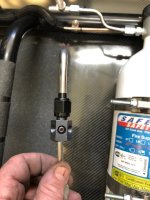
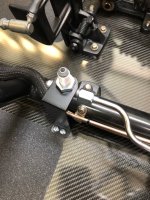
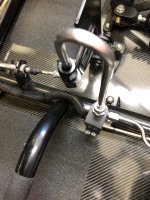
Its hard to tell without the console in But I used a string from each nozzle to measure
where the flow would go right in the lap and legs of the occupants ...
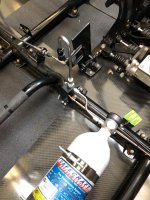
I mounted the Pull handle on dash within reach of both occupants - this system also allows two handles to be used in case the car is wide
this pic is with the console out of the car
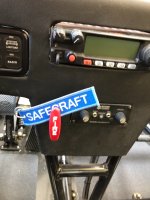
You can see the "jesus" clip that is normally pushed all the way through the handle to stop accidental discharge
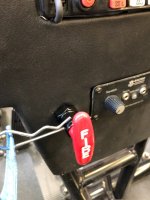
I did the same in the back with nozzles over headers - the Nozzles actually blanket the engine
------
Here is an ESS example I did in one of my other cars - this was 2 seater with big 5L bottle - the ESS systems are way bigger that the safecraft
this was Aluminum tubing and dual head design so no T required - If I did a 4 seater I would T and run another nozzle in the back
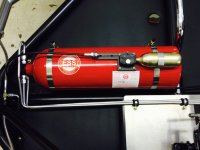
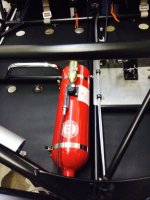
This car did not have a Console - but similar Nozzle positioning
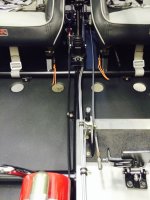
I did the pull handle between the seats
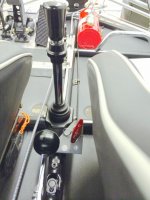
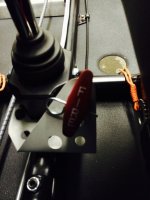
I alway use a marker to indicate the flow of the nozzle just in case it turns when tightening it it - Sand cars are tight to work in ...
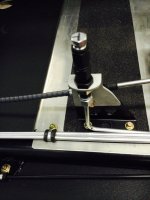
On that car I mounted the nozzles into body work for a cleaner look

Those who have duned with me know I am a freak for fire safety. If you go fast in uncontrolled conditions stuff happens. I have seen first hand what fire can do, and some GD members (LRS comes to mind) have been in off road fires and its not fun.
Most Sand cars don't have fuel cells and firewalls, many have windshields, padded interiors and lots of Horsepower. The same is true for a lot of SxS with big power hungry lights and stereos and way more plastic than a sand car.
I started over 10 years ago putting fire systems on all my cars and many of my Buddies cars, not because I think a systems can put out a big fire, but because statistically you have a way better chance of making it out if you can slow down the fire, and you might just save the car if you are lucky.
If you have a little 2 or 5LB fire extinguisher in your car you basically are nit putting much out and likely not buying yourself anytime to "escape" and if you use it you will create a huge mess and ruin a lot of the car in the process (Paint, wiring, polished aluminum)
I am not a fire expert but I have learned a little and can say that the cost of a fire system is not even what I spend on fuel and food for weekend and a reasonable install can be done a couple hours by anyone .
So here is my take ....Essentially there are two types (yes there are more and combos of each) there is AFFF which is a foam fire retardant that smothers the flames and prevents re-ignition - its basically soap ... It's made of animal fat. Its great stuff, it hangs on to surfaces and if it wets you it stops the fire from burning you. it also goes by the other name cold Fire. There are a few brands of it - mainly from Europe and everyone but ESS IMO is inferior. ESS is the only one that creates the Foam in the container was the C02 cartridge that pressurizes it fires - that is a key to using it in Cars. they don't rely on the nozzle to make the foam (if sand gets in the nozzle of others - it comes out like soapy water - not effective.
Basically you fill a tank with water and a soap mix and when you pull a Handle - it shoots C02 from a cartridge into the tank and foams it, the solution travels through a tube and puts out the fire (more on that later). The downside of AFFF is that it freezes - well the water freezes or gets slushy and it does not work at all. people who run it in cold weather - like when Glamis gets cold at night - either keep the car in the trailer or use a heater blanket over the tank - neither is sure practical. a 2.5L Bottle is usually OK for 2 seat car and 5L is good for 4 seat car - it comes down to the number of Nozzles. I used these systems on mostly all cars. they are great for open cars "mostly" because foam lays down. Clean it is not as easy as regular soap and water due to the PH but it cleans up WAY better than an ABC fire extinguisher.
The second type is a Halon derivative - since Halon was outlawed due to environmental concerns, there are two new types 3M Novec 1230 and Dupont FE36 Both work by starving the fire of oxygen, but unlike Halon these are heavier than Air and Blanket and area faster than AFFF and they work good in mostly open cars and they leave No residue - so no clean up and they don't freeze.
I have used all three of these types - Firebottle brand uses FE36 and Safecraft uses Novec 1230. Firebottle was my goto early on because all the drag racers used it. I went to ESS for a long time because thinking like a racer again - it has the advantage of being able to refill at home cheaply where the others need to be sent back to refill and cost lots of $$
As a racer you can discharge a bottle by mistake and if you don't have a spare ir can't refill you cannot race. As a Duner if I ever have to use the Bottle I and likely not going duning the same weekend ..
Mu latest car I moved to safecraft because I wanted a mess free solution and they are supporting the sport a lot. They also have SxS specific kits that automatically put out "belt" fires and engine related fires with those (hot turbo oil on the exhaust type stuff)
All three of those systems come with Aluminum tubing and aluminum nozzles - thats important - the cheap systems that have plastic tubing usually fail because by the time you pull the handle to extinguish the fire, the tubing already melted and no material makes it out ...
====
The key to either is buy the right kit (number of nozzles and bottle size) and place the bottle and nozzles in the right spot
Ideally 3 rules:
1. Always cover the areas of ignition - on a sand car that means face the nozzles at the headers and Fuel injectors. If I have extra nozzles I will also target the fell pump, but I have never seen one short and cause a fire. I have been told so many times not to bother pointing nozzle at the gas tank because there is no way you are going stop gallons of fuel from coming out, so theta just a complete waste
2. save the occupants - face a nozzle at the feet of the occupants since fuel fires usually travel along the floor. If you have extra nozzles face then the back of the heads of the occupants this way you are covered no matter where you are even upside down
3. Place the pull handle where both front seat occupants can get to it and / or someone outside can pull it
You also need to know the system and how the nozzles spray. For instance the ESS has small nozzles and you can place they straight up and down (just use common sense on direction of the spray) No sand is "likely "getting in the nozzle and down the tube. The Firebottle and Safecraft use Big Nozzles and you should mount them upside down so no sand gets in the tune and clogs it up.
Also pay attention to how you place the bottle even though you might be on your side, I always place it assuming I am gonna be right side up or upside down. It makea difference in efficiency. while there is way more to cover. these are basics - here are a couple pics of the stystm I did in my car recently
While the kit comes with aluminum line and you have to 37 degree flare the ends (like AN) to install you can use a 45 degree stand flare tool and aluminum "gives" enough to seal, I like using stainless tubing, its harder to work with but it allows me to mount nozzles cleaner with less support. Bottle is horzontal with gauge up and mounted through the floor securely - it only weighs 5 lbs But I don't want it dislodging in crash
Here are some pics of this and previous Install ...

I T'd the line so I could get a nozzle for Driver and Passenger. I tapped and plugged the center hole on the nozzle to give side squirter more force. I made a bracket to hold the Bulkhead T more securely.


I bent the stainless line do the nozzle points down to keep sand and crap out of the lines - I did the same in the back of the car over the headers



Its hard to tell without the console in But I used a string from each nozzle to measure
where the flow would go right in the lap and legs of the occupants ...

I mounted the Pull handle on dash within reach of both occupants - this system also allows two handles to be used in case the car is wide
this pic is with the console out of the car

You can see the "jesus" clip that is normally pushed all the way through the handle to stop accidental discharge

I did the same in the back with nozzles over headers - the Nozzles actually blanket the engine
------
Here is an ESS example I did in one of my other cars - this was 2 seater with big 5L bottle - the ESS systems are way bigger that the safecraft
this was Aluminum tubing and dual head design so no T required - If I did a 4 seater I would T and run another nozzle in the back


This car did not have a Console - but similar Nozzle positioning

I did the pull handle between the seats


I alway use a marker to indicate the flow of the nozzle just in case it turns when tightening it it - Sand cars are tight to work in ...

On that car I mounted the nozzles into body work for a cleaner look


